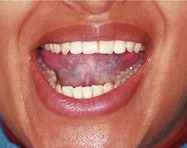Case• 8. Painful trismus
SUMMARY
A 27-year-old woman is unable to open her mouth normally. What is the diagnosis and how should she be managed?
History
Complaint
The patient is unable to open her mouth more than half the normal distance.
History of complaint
She has had sporadic painless clicks from her right jaw joint for many years. Recently the click has become louder and painful. On occasions there has been some hesitancy of opening just at the position where the click would normally be felt. Three days ago, while eating a particularly chewy piece of meat, she felt a sudden pain in front of the right ear and since that time she has been unable to open her mouth more than about half way.
Medical history
The patient is otherwise well but she has suffered from previous episodes of knee pain and was seen by a rheumatologist who diagnosed generalized hypermobility of her joints.
Social history
The patient used to be a keen and successful gymnast as a teenager.
Examination
Extraoral examination
The patient is apyrexial and appears well. There is no facial swelling and the skin colour over the preauricular regions is normal. There is tenderness on palpation over the right condyle but no tenderness on the left side. There is generalized muscular tenderness, particularly of the right masseter and the right lateral pterygoid muscles. Examination of the fingers, wrists and elbows shows an increased range of joint movement.
Intraoral examination
▪ The patient’s appearance is shown inFigure 8.1. She is trying to open her mouth to the maximum extent. What do you see?
There is limited mouth opening and a deviation towards the right side. If you were able to examine the patient you would find that the opening, measured between the tips of the incisor teeth, is 23 mm. Lateral excursions of the mandible were measured at 8 mm to the right and 1 mm to the left. The patient readily achieved a normal position of maximum intercuspation between upper and lower teeth.
Differential diagnosis
▪ The patient has trismus. What is trismus?
The definition of trismus is reduced opening caused by spasm of the muscles of mastication but the term is used loosely for all causes of limited opening. True trismus is usually temporary.
▪ What are the causes of trismus?
Causes of limitation of opening include:
| Intra-articular causes | Internal derangement of the joint |
| Fractured condyle | |
| Traumatic synovitis | |
| Septic arthritis | |
| Osteoarthrosis | |
| Inflammatory arthritis, (e.g. rheumatoid or psoriatic) | |
| Ankylosis (secondary to trauma or infection) | |
| Lesions of the condylar head (e.g. osteochondroma) | |
| Extra-articular causes | Trauma (e.g. fractured mandible not involving the condyle) |
| Postsurgical removal of impacted lower third molar or recent prolonged dental treatment | |
| Acute infections of the oral tissues especially involving the cheeks or the muscles of mastication, usually dental in origin | |
| Muscle spasm of masticatory muscles (e.g. myofascial pain) | |
| Disease of masticatory muscles (e.g. myositis ossificans) | |
| Scarring of muscles, skin or mucosa (e.g. submucous fibrosis, scleroderma or after radiotherapy) | |
| Inflammatory conditions of the oral mucosa (e.g. painful ulcerative conditions or other forms of stomatitis) | |
| Tetanus |
There are three conditions that are common and they are usually classified according to the ‘Research Diagnostic Criteria’ or RDC system.
Myofascial pain dysfunction syndrome, also known as arthromyalgia or, inappropriately, temporomandibular joint pain-dysfunction. In this condition the masticatory muscles, which move the joint, are the source of the pain and the condition has little />
Stay updated, free dental videos. Join our Telegram channel

VIDEdental - Online dental courses



